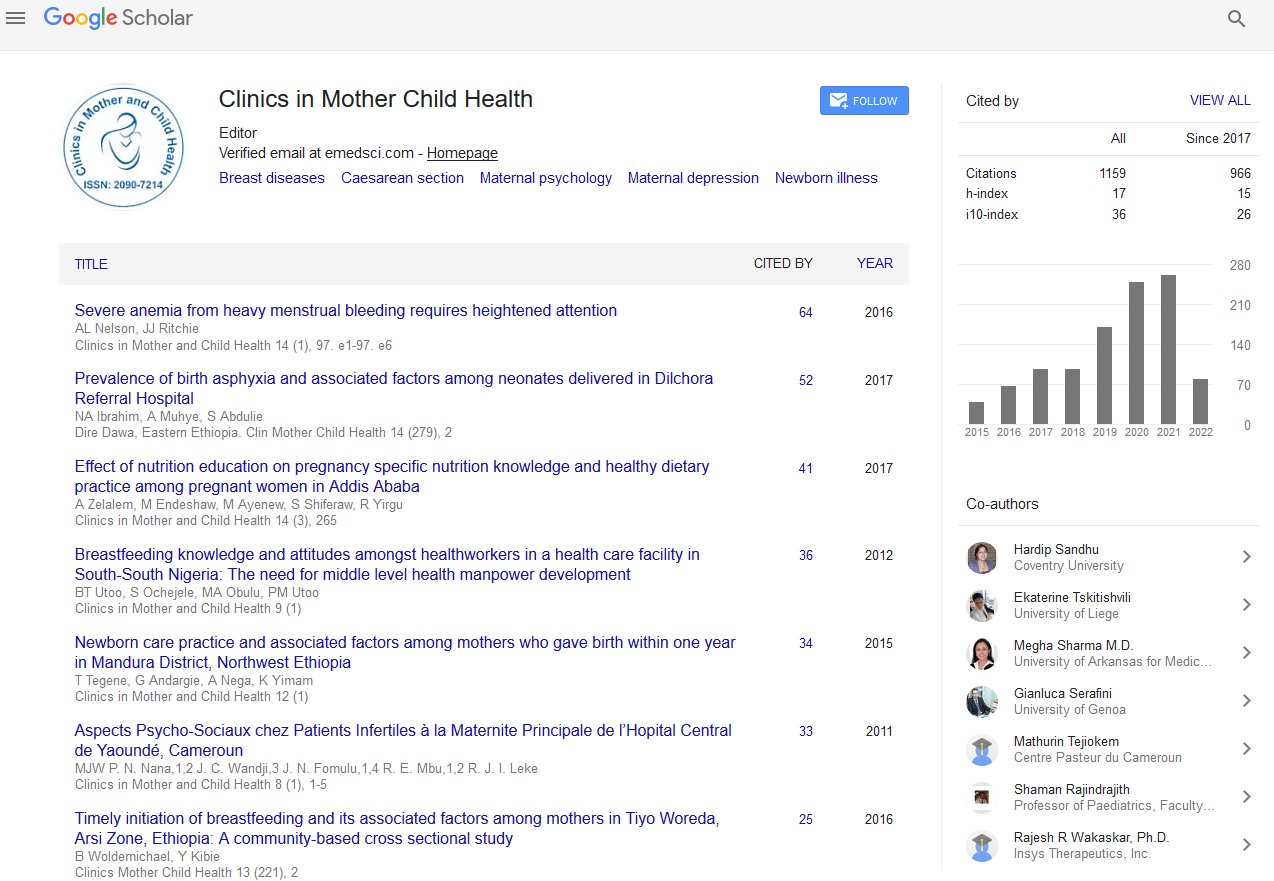Indexed In
- Genamics JournalSeek
- RefSeek
- Hamdard University
- EBSCO A-Z
- Publons
- Geneva Foundation for Medical Education and Research
- Euro Pub
- Google Scholar
Useful Links
Share This Page
Journal Flyer

Open Access Journals
- Agri and Aquaculture
- Biochemistry
- Bioinformatics & Systems Biology
- Business & Management
- Chemistry
- Clinical Sciences
- Engineering
- Food & Nutrition
- General Science
- Genetics & Molecular Biology
- Immunology & Microbiology
- Medical Sciences
- Neuroscience & Psychology
- Nursing & Health Care
- Pharmaceutical Sciences
Abstract
The Effect of Omega/Heparin Association on the Obstetric Outcome of Pregnant Women with Thrombophilia: A Pilot Study
Marcelo Lopes de Souza Mendes, Lucas Campos Amaral, Daniel Henrique de Siqueira Dornelas, Lucas Palhares Baeta Duarte, Giovanna Carvalho Silva, Mariana Pinto Sirimarco, Alexander Cangussu Silva, Clarissa Rocha Panconi, Larissa Milani Coutinho, Patrícia de Oliveira Lima, Sirleide CorrÃ?ªa Rangel, Flávia Lima Miranda, Maria Luiza Braga Leal, Geovana Tiango Gabriel, Gabriel Duque Pannain, Marcus Gomes Bastos and Juliana Barroso Zimmermmann*
Introduction: It is possible assuming that thrombophilias can change the optimal placental function, as well as lead to infarctions, impaired maternal-fetal exchange mechanisms and even to fetal death. Placental hypoxia determines a vicious cycle comprising oxidative stress, vasoconstriction and impaired fetal oxygenation. Prophylactic heparin use throughout pregnancy has been recommended in some thrombophilia cases because it acts on the coagulation cascade. However, although heparin does not cross the placental barrier and is safe for the fetus, not all patients can use it. Its administration route (parenteral) is not practical and even its prophylactic use is not necessarily harmless, as seen in different thrombocytopenia, gastrointestinal and cerebral bleeding reports. Thus, finding clinical alternatives for these pregnant women would help significantly improving the current medical practice. The use of essential fatty acids (EFAs) is a new perspective that appears to be applicable in daily medical practice, because it facilitates the blood flow and tissue oxygenation, since they reduce vascular resistance and platelet aggregation.
Methods: This study is a randomized, controlled, unblind, parallel, three-arm, open-label prevention trial conducted with pregnant women diagnosed with thrombophilia, who were treated in the Obstetrics Services of University Hospitals belonging to UFJF and to Medical School of Barbacena. All the patients were divided in two groups: Group 1=Hereditary thrombophilia patients who used 40 mg of heparin/day (enoxaparin) from the 6th pregnancy week on; Group 2 Patients with acquired or hereditary thrombophilias associated with risk factors for preeclampsia, according to ACOG19 (chronic kidney disease, previous diabetes mellitus, chronic arterial hypertension and collagenoses).
Results: The current study assessed 38 pregnant women. Patients’ mean age was 32.9 ± 5.0 years. The pulsatility index in the second gestational trimester (24 to 28 weeks) was compared based on treatments. Patients treated with the H+ASA+omega association recorded the lowest pulsatility index; however, there was not statistically significant difference between groups (p>0.05). Uterine artery resistance index in the second gestational trimester (24 to 28 weeks) was also compared based on treatments. Patients treated with the H+ASA+omega association recorded the best resistance index, however, there was not statistically significant difference between groups (p>0.05). The group treated only with heparin recorded the lowest fetal weight, although there was not statistically significant difference between groups.
Conclusion: Our results are preliminary, and a crude evaluation of the data shows a decrease in the pulsatility and resistance indices of the uterine art. With the increase of patients in the analysis, we hope that the statistical results can demonstrate this improvement of placental flow.
Published Date: 2019-09-17; Received Date: 2019-09-04


